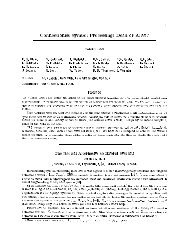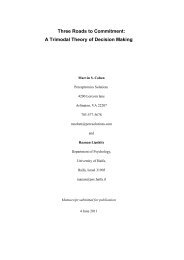Three Roads to Commitment: A Trimodal Theory of Decision Making
Three Roads to Commitment: A Trimodal Theory of Decision Making
Three Roads to Commitment: A Trimodal Theory of Decision Making
You also want an ePaper? Increase the reach of your titles
YUMPU automatically turns print PDFs into web optimized ePapers that Google loves.
<strong>Three</strong> <strong>Roads</strong> <strong>to</strong> <strong>Commitment</strong>: A <strong>Trimodal</strong> <strong>Theory</strong> <strong>of</strong> <strong>Decision</strong> <strong>Making</strong> 3<br />
Figure Captions<br />
Figure 1. The TDM framework, showing successful transitions from the initial state associated with each decision<br />
mode <strong>to</strong> commitment <strong>to</strong> a singular course <strong>of</strong> action, which is followed by reassessment and/or implementation.<br />
Figure 2. How various research paradigms are represented in the TDM framework, from left <strong>to</strong> right, <strong>to</strong>p <strong>to</strong> bot<strong>to</strong>m:<br />
the normative core <strong>of</strong> Rational Choice <strong>Theory</strong>, Klein’s Recognition-Primed <strong>Decision</strong> <strong>Making</strong> (RPD) model,<br />
Connolly’s hedge clipping strategy; Beach’s Image <strong>Theory</strong>.<br />
Figure 3. Representation in TDM framework <strong>of</strong> five decision types in Orasanu & Fischer’s (1997) decision<br />
taxonomy. Top left: Condition-action and Go-No Go. Bot<strong>to</strong>m left: Choice. Middle column: Procedural management.<br />
Right column: Scheduling. Broken lines represent ways the decision cycle can fail <strong>to</strong> deliver an actionable<br />
commitment.<br />
Figure 4. S<strong>to</strong>ry building in the TDM framework (above) and evolution <strong>of</strong> corresponding s<strong>to</strong>ry model (below). In<br />
s<strong>to</strong>ry models, lightly outlined rectangles are expectations, planned actions, or hypothesized explanations. Heavily<br />
outlined rectangles are events or actions that have been observed. Arrows represent causal influence. X’s mark<br />
violations <strong>of</strong> expectations, and dotted lines show how rebuttals are used <strong>to</strong> explain these failures. Broken lines<br />
represent ways the decision cycle can fail <strong>to</strong> deliver an actionable commitment.<br />
Figure 5. TDM model <strong>of</strong> action uncertainty. Ovals represent types <strong>of</strong> uncertainty, and rounded rectangles represent<br />
methods. Broken lines represent ways the decision cycle can fail <strong>to</strong> deliver an actionable commitment.<br />
Figure 6. Increase in degree <strong>of</strong> success as a function <strong>of</strong> time or cognitive effort invested, for different uncertainty<br />
handling methods.<br />
3




